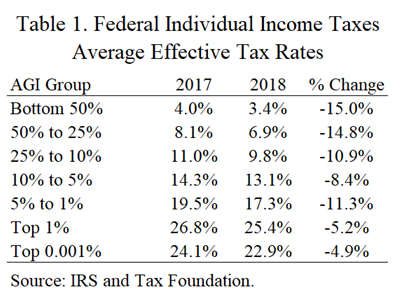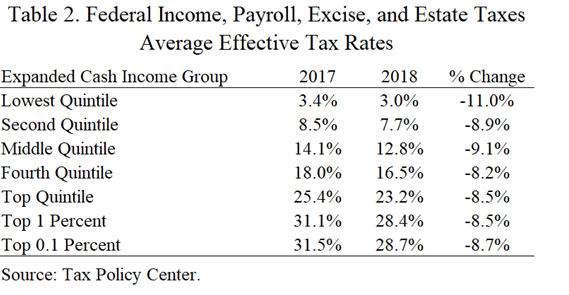When making reforms to the federal tax system, policymakers should be aware of trends around the world. We live in a global economy with large flows of cross-border investment and substantial flows of highly skilled labor. Policymakers should focus on making America the best place in the world for entrepreneurship and investment. Unfortunately, the president’s proposed increases in corporate taxes and capital gains taxes would make the U.S. tax system much less competitive.
According to KPMG, the average corporate tax rate for 173 countries in 2021 is 23.7 percent, taking account of both national and subnational taxes.21 The average rate in Asia is 21.4 percent and the average in the European Union is 20.7 percent. The current U.S. federal-state rate is 27 percent. With the president’s proposed increase, the U.S. rate would rise to 33.4 percent, thus far above the averages of our trading partners.
The downward trend in corporate tax rates in recent decades has been beneficial for the global economy because corporate taxes are an inefficient source of revenue. An OECD study examining the economic effects of different taxesconcluded, “Corporate taxes are found to be most harmful for growth.”22 Corporate taxes are nontransparent and ultimately land on individuals, so it makes more sense to tax individuals directly.
Some policymakers are concerned that declining corporate tax rates have starved governments of revenue. Treasury Secretary Janet Yellen recently worried about a“30-year race to the bottom on corporate tax rates,” and wants to make sure that corporate taxes “raise sufficient revenue to invest in essential public goods and respond to crises.”23
Despite the decline in corporate tax rates, overall corporate tax revenues have not declined. For 22 OECD countries with good data back to 1980, I calculated the average corporate tax rate and average corporate tax revenues as a percent of GDP.24 The average rate fell from 47 percent in 1980 to 25 percent in 2019. But rather than falling, corporate tax revenues are up since the 1980s. Corporate tax revenues for the 22 countries rose from 2.4 percent of GDP on average in the 1980s to 2.9 percent in the 2010s.
The administration also proposes to raise the federal long-term capital gains tax rate from 23.8 to 43.4 percent. Many economists think that the revenue-maximizing capital gains tax rate is around 28 percent, so the government would likely lose revenues from such a rate increase while undermining investment in growth businesses.25 Note that state capital gains tax rates are loaded on top of the federal rate, such that the average federal-state rate with the administration’s increase would be 48 percent.26
Nearly every nation in the OECD has lower tax rates on capital gains than ordinary income, which makes sense because of the effects of inflation and the importance of entrepreneurship and growth businesses. Also, raising the capital gains tax rate would increase the tax code’s bias against corporate equity in favor of debt, which would result in more corporate leverage and less business stability during downturns. Also, if you view the ideal tax system to be a consumption-based system, then capital gains should not be taxed.27
A 2018 analysis by the OECD looked at combined tax rates on corporate equity, including the individual long-term capital gains tax rate and the corporate income tax rate.28 The analysis included national and subnational taxes. For 32 countries other than the United States, the average tax rate was 36 percent.29 The comparable U.S. rate today is 46 percent. By this measure, the U.S. tax rate on long-term capital gains is already substantially higher than the average of our trading partners, and the president’s proposal would push it up further.
An increase in the capital gains tax rate would undermine entrepreneurship and angel investment in innovative industries.30 Today, there are about 335,000 wealthy angel investors across the nation who fund a diversity of startup businesses.31 They take large risks, invest their time, and often wait five years or more until a small share of their startup investments pay off. They exit, realize a capital gain, and invest in new startup businesses.
Wealthy angels support entrepreneurs in a virtuous growth cycle. Startups that succeed generate returns for investors and entrepreneurs, who then reinvest their wealth into the next round of startups. Higher capital gains taxes would throw a wrench into the works by reducing incentives to invest in startups and by reducing incentives for skilled individuals to leave safer salaried work to take the risks of starting a business.
Since about eight percent of all U.S. companies shut down each year, the creation of new businesses is crucial to sustaining economic growth. Companies with the potential for rapid growth often receive early funding and guidance from angels. Angel-funded startups challenge incumbent businesses, restrain prices, and introduce new products. Some famous angel-funded startups that grew into large businesses include Apple, Amazon, Cisco, Google, Best Buy, Home Depot, Costco, Tesla, and Uber.
If you are worried about the power of big tech companies, the best restraint on them is making sure we have a good climate for angel investment and high-growth startup businesses to challenge dominant companies. Raising capital gains taxes would raise little government revenue and could create serious damage to America’s innovation industries.
In sum, while some of the activities that the Biden administration proposes to fund in the Jobs Act and Families Act may be worthwhile, it makes more sense to fund them at the state, local, or private levels. Federal intervention adds bureaucracy and reduces the freedom and flexibility of nonfederal entities to tackle problems in diverse and innovative ways.
Moreover, the tax increases proposed to fund the Biden proposals would put the United States in an uncompetitive position in the global economy and undermine the growth of startups and technology industries.
Thank you for holding these important hearings.



